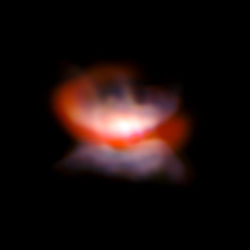| Observation data Epoch J2000 Equinox J2000 | |
|---|---|
| Constellation | Puppis |
| Right ascension | 07h 13m 32.31810s [1] |
| Declination | −44° 38′ 23.0630″ [1] |
| Apparent magnitude (V) | 5.10 [2] 2.6–6 (GCVS) [3] 6–8 (1995 – ) [4] |
| Characteristics | |
| Evolutionary stage | Red-giant branch [5] |
| Spectral type | M5IIIe [3] |
| U−B color index | +1.24 [2] |
| B−V color index | +1.56 [2] |
| Variable type | SRb [3] |
| Astrometry | |
| Radial velocity (Rv) | 33.0 [6] km/s |
| Proper motion (μ) | RA: 106.31 [1] mas/yr Dec.: 324.99 [1] mas/yr |
| Parallax (π) | 15.61±0.99 mas [1] |
| Distance | 210 ± 10 ly (64 ± 4 pc) |
| Details | |
| Mass | 0.659±0.043 [6] M☉ |
| Radius | 123±14 [6] R☉ |
| Luminosity | 1,490±150 [5] L☉ |
| Surface gravity (log g) | 0.078±0.027 [6] cgs |
| Temperature | 3,500±250 [6] K |
| Age | 10 [6] Gyr |
| Other designations | |
| L2 Puppis, L02 Pup, HR 2748, CD−44°3227, HD 56096, LTT 2769, SAO 218549, HIP 34922 | |
| Database references | |
| SIMBAD | data |
L2 Puppis (also known as HD 56096) is a giant star in the constellation of Puppis and is located between the bright stars Canopus and Sirius. It is a semi-regular pulsating star, and is intermittently visible to the naked eye.


